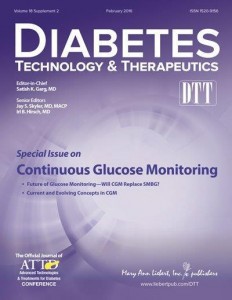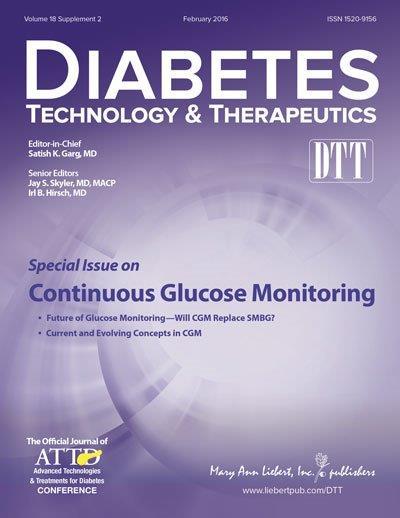The artificial pancreas is moving closer to becoming a reality for adults and children with diabetes, thanks in no small part to the use of continuous glucose monitoring (CGM).

As the accuracy, reliability, adoption, and successful use of Continuous Glucose Monitoring (CGM) continue to increase, the ultimate goal of combining CGM with an insulin pump and sophisticated algorithms for automating the control and suspension of insulin infusion — known as the “artificial pancreas” — moves closer to becoming a reality.
A detailed look at the development and future promise of CGM in adults and children with diabetes, and at the challenges facing successful commercialization of CGM and artificial pancreas technology is presented in a special issue of Diabetes Technology and Therapeutics (DTT), a peer-reviewed journal from Mary Ann Liebert, Inc., publishers. The issue is available free to download on the DTT website.
In the article “Continuous Glucose Monitoring: A Review of Successes, Challenges, and Opportunities“, David Rodbard, MD, Biomedical Informatics Consultants LLC (Potomac, MD), examines the barriers to clinical implementation of CGM systems that have limited their use despite tremendous improvements in recent years.
In addition to cost and reimbursement issues, challenges to more widespread utilization have included the lack of U.S. FDA approval for insulin dosing and for use in hospitals and intensive care settings, need for recalibrations and periodic replacement of sensors, and insufficient education of physicians and patients.
Continue Reading Below ↓↓↓
Jort Kropff, MD and J. Hans DeVries, MD, PhD, University of Amsterdam (The Netherlands), explore how CGM technology has affected diabetes treatment and clinical outcomes.
In the article entitled “Continuous Glucose Monitoring, Future Products, and Update on Worldwide Artificial Pancreas Projects”, the authors describe innovative approaches in development for CGM and review recent and ongoing artificial pancreas studies.
The special issue also includes the articles “CGM Retrospective Data Analysis” by Gary Scheiner; “Improved Accuracy of Continuous Glucose Monitoring Systems in Pediatric Patients with Diabetes Mellitus: Results from Two Studies” by Lori Laffel; “Use of Glucose Rate of Change Arrows to Adjust Insulin Therapy among Individuals with Type 1 Diabetes Who Use Continuous Glucose Monitoring” by Jeremy Pettus and Steven Edelman; “Direct Evidence of Acetaminophen Interference with Subcutaneous Glucose Sensing in Humans: A Pilot Study” by Ananda Basu, Sona Veettil, Roy Dyer, Thomas Peyser, and Rita Basu; and “Reimbursement for Continuous Glucose Monitoring” by Lutz Heinemann and J. Hans DeVries.
“Sometime in the next decade I expect CGM to replace self-monitoring of blood glucose (SMBG) and to be considered a stand-alone entity,” says DTT Editor-in-Chief Satish Garg, MD, Professor of Medicine and Pediatrics at the University of Colorado Denver, in his Editorial “The Future of Glucose Monitoring”.
With different approaches to an artificial pancreas currently in development and ongoing advances in predictive algorithms for automated control, he adds: “I am hopeful that some version of a closed-loop system will be available in the U.S. within the next two years.”
This special issue was supported by Dexcom.
Source & Photo Credit: Mary Ann Liebert, Inc./Genetic Engineering News
Journal: Diabetes Technology & Therapeutics











